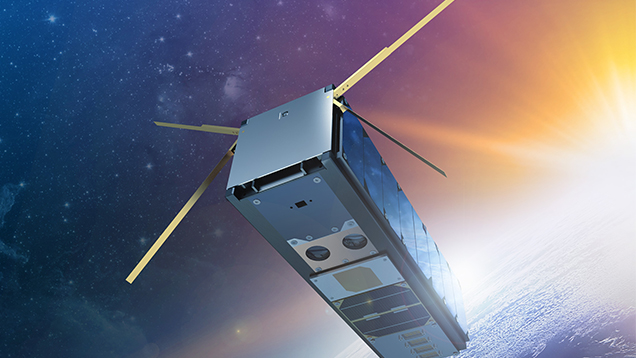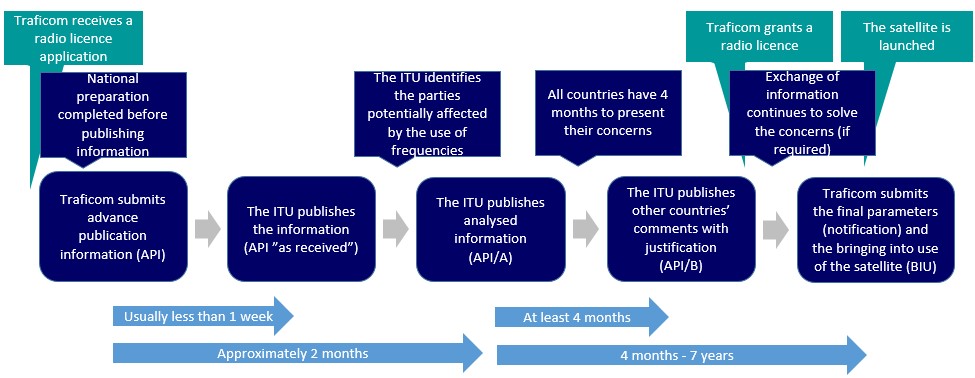
Traficom enables the usage of radio frequencies for space activities
From the beginning, the exploration and conquest of space have been based on the use of electromagnetic radiation – frequencies. Even though Finnish space expertise has been developed for decades, Finland joined the group of space nations with regard to radio frequencies by launching Aalto-1, its first satellite, in 2017. Since then, the role of the Finnish Transport and Communications Agency (Traficom), Finland’s administrative authority for frequencies, in enabling the use of radio frequencies in Finnish space activities has grown. In this text, we will describe the management of frequencies in the space sector in more detail. In addition to frequency management in the space sector, Traficom manages the Public Regulated Service (PRS) of the European Galileo satellite positioning system.
Even though Finland joined the group of space nations in 2017, this did not mark the take-off for the use of space in Finland. We have used signals originating from space in research, TV programmes, phone calls, programme transfers, weather satellite and remote sensing data, and many other things for decades now. To this end, we have transmitted signals at radio frequencies to space – naturally with the required radio licences.
In Finland, Traficom is responsible for the national frequency administration and acts as the radio licence authority, safeguarding the effective and interference-free use of radio frequencies. This applies not only to the use of radio transmitters on land, at sea and in the air, but also to licences for radio transmitters in space objects registered in Finland. In practice, communications from satellites to Earth or from Earth to satellites, including the transmission of control commands to satellites and that of data collected by satellites to ground stations, always requires a wireless connection, which currently still requires the use of radio frequencies. As a general rule, each radio transmitter in the satellite system needs a radio licence before it can be used. Exceptions to this rule are licence-exempt radio transmitters.
Because frequencies know no national boundaries, their use must be agreed in an international cross-boundary context. The use of frequencies includes a few basic principles that are complied with in international agreements: the use of frequencies must be efficient relative to the benefits sought. This means the equipment used in space activities must be modern and appropriate to obtain a radio licence. In addition, the use of radio frequencies cannot primarily cause harmful interference to other existing or planned radio communications. This in turn calls for pre-planning, coordination and openness between users of frequencies.
The International Telecommunication Union regulates frequencies
The UN’s International Telecommunication Union (ITU) is the regulatory body for radio frequencies. The Radio Regulations maintained by the ITU define purposes of use for radio frequencies in the spectrum from 8.3 kHz to 275 GHz. The document is updated at the World Radiocommunication Conference (WRC) held every four years, as a result of which the purpose and provisions (terms of usage) of use of different frequency bands are defined by region (e.g. Europe–Africa–Middle East) or globally. In addition, individual countries can make reservations or define conditions for their national use of frequencies. During the four-year research cycle, Traficom participates with the Ministry of Transport and Communications in preparing the next conference, agreeing international rules, and determining the outcome taking into account Finland’s interests.
At a national level, each country grants radio licences for the use of radio devices in accordance with internationally agreed conditions. The farther we go from the external boundary of a country, the more unlikely it usually is that a radio device will cause interference to the use of radio frequencies in the neighbouring country. However, in space activities, we will directly end up in a situation where the radio transmitter of a low Earth orbit satellite can easily be heard in several countries, and in some cases, the use of radio transmissions in the territories of other countries, such as at ground stations or generally in remote sensing operations, can even be intentional. To ensure effective and interference-free use of frequencies, methods have been agreed within the ITU upon the use of satellite frequencies internationally. In this procedure, Traficom is an active authority not only in promoting the requirements and conditions for using Finnish satellite frequencies, but also in supervising that frequencies significant for Finland are interference-free, while other countries plan their use of frequencies.

The national use of frequencies is planned first
Radio frequencies are limited and valuable natural resources that are required for various purposes in modern society. The needs for frequencies in mobile networks have especially increased during the last few decades as the volume of wirelessly transferred data has multiplied. Even though there is a significantly growing need for space activities, they need to compete for limited frequency resources with other activities.
To ensure the effective use of frequencies, it is inappropriate to reserve frequencies for a certain activity if they remain unused for that activity. As a result, frequency planning is carried out for satellites and their ground stations to identify applicable frequencies. Frequencies are sought through "terrestrial" frequency bands used by professional mobile radio (PMR) networks, radio links or radar systems, provided that a status suitable for satellites has been set for them in the ITU’s international Radio Regulations. In the best case, a suitable frequency can be found between two terrestrial frequencies; in some cases, a shared frequency may have to be used if the interference risk can be made as low as possible. In particular, ground stations that transmit satellite data can operate without causing interference to other radio communications if they are located in sparsely populated areas.
Some space applications require a global frequency band with as little interference as possible. Remote sensing is an example of such services also used to a significant extent by Finnish satellites. In this case, radio frequencies can be assigned to frequency bands in which conditions have been defined for different services to ensure compatibility in accordance with the ITU’s Radio Regulations.
To ensure the equal availability of radio frequencies and their effective, appropriate and sufficiently interference-free use, the uses of radio frequencies have been defined for each frequency band. Traficom maintains the Radio Frequency Regulation and the national Frequency Allocation Table published attached to it, as well as the frequency database and radio licence register for the national use of frequencies. By coordinating these data in frequency planning and through Traficom’s internal cooperation, the frequencies required by satellites can be planned at a national level. This is followed by the most time-consuming part of licensing: the international ITU process.
Negotiating a radio licence may take years – thorough frequency planning forms the basis of cooperation
The radio licence process for satellites and their ground stations practically always requires international negotiations. The process can start once the licence applicant has provided Traficom with the required information about the intended purpose of operation. This means not only technical radio parameters such as the frequency band, modulation and power, as well as the details of the antennas used, but also specifications related to satellite orbits or ground station locations. Using this information, the level of interference caused by the satellite to other frequency users can be modelled. Compiling information and specifying details, making certain technical calculations and verifications, and agreeing upon different final orbit scenarios with the customer usually takes from weeks to months.
Once suitable frequencies have been found in Finland’s internal process, the international process starts through the ITU.
In certain situations, the frequencies used must be coordinated with other frequency users with regard to both satellites and ground stations. The ITU acts as an intermediary through which information flows, but Traficom maintains direct contact with the frequency administrations of other countries to agree upon the use of frequencies. In these cases, an agreement may not be established for the frequencies and conditions defined by Finland, which is why coordination always involves time-consuming negotiations and uncertainties that must be taking into account when planning satellite launch schedules. However, effective frequency planning and the selection of correct technical parameters can improve the opportunities to reach a mutual understanding with the frequency administrations of other countries.

The ITU’s satellite frequency information procedure is based on an agreed process, in which Traficom’s advance publication information is followed by a two-month pre-audit period before the issuance of the information. This starts the four-month commenting period, during which any of the ITU’s 193 member countries can present their concerns about the planned use and request them to be resolved. In Finland, Traficom must respond to these concerns in correspondence independently or with the applicant. No earlier than six months after Traficom has submitted its first official information for the ITU, the ITU will publish a summary of justified concerns presented by other administrations.
Correspondence aims to achieve a mutual understanding about the conditions based on which a satellite and its ground stations can be used. In some cases, the plan may be respecified with regard to the frequency used, for example, to ensure the compatibility of different radio systems.
All this takes at least six months, but typically much longer, from the issuance of the first information. Because the satellite launch schedule may have been set before the ITU process has been completed, the licence can be granted conditionally before the end of the process. A conditional licence means that in the case of harmful radio interference, the use of a radio transmitter may even have to be suspended until the interference has been eliminated, and its recurrence has been prevented.
Once the radio licence has been granted, it is time to launch the satellite. When the satellite is in its orbit, and radios are operational, Traficom will submit information about the bringing into use of frequencies to the ITU. This information must be submitted within seven years of the first publication.
All in all, space activities are soaring in Finland. In addition to its role as the administrative authority for frequencies, Traficom’s National Cyber Security Centre is the national authority for Galileo satellite positioning service. The Government’s proposal for the act on the ground station operations of satellites has been submitted to Parliament, and if implemented, it will provide Traficom with new tasks as the licensing authority. Traficom supports growth in the space and satellite sector by aiming to enable suitable frequencies for operators for testing, research and development, and operations safely, smoothly and sustainably.





